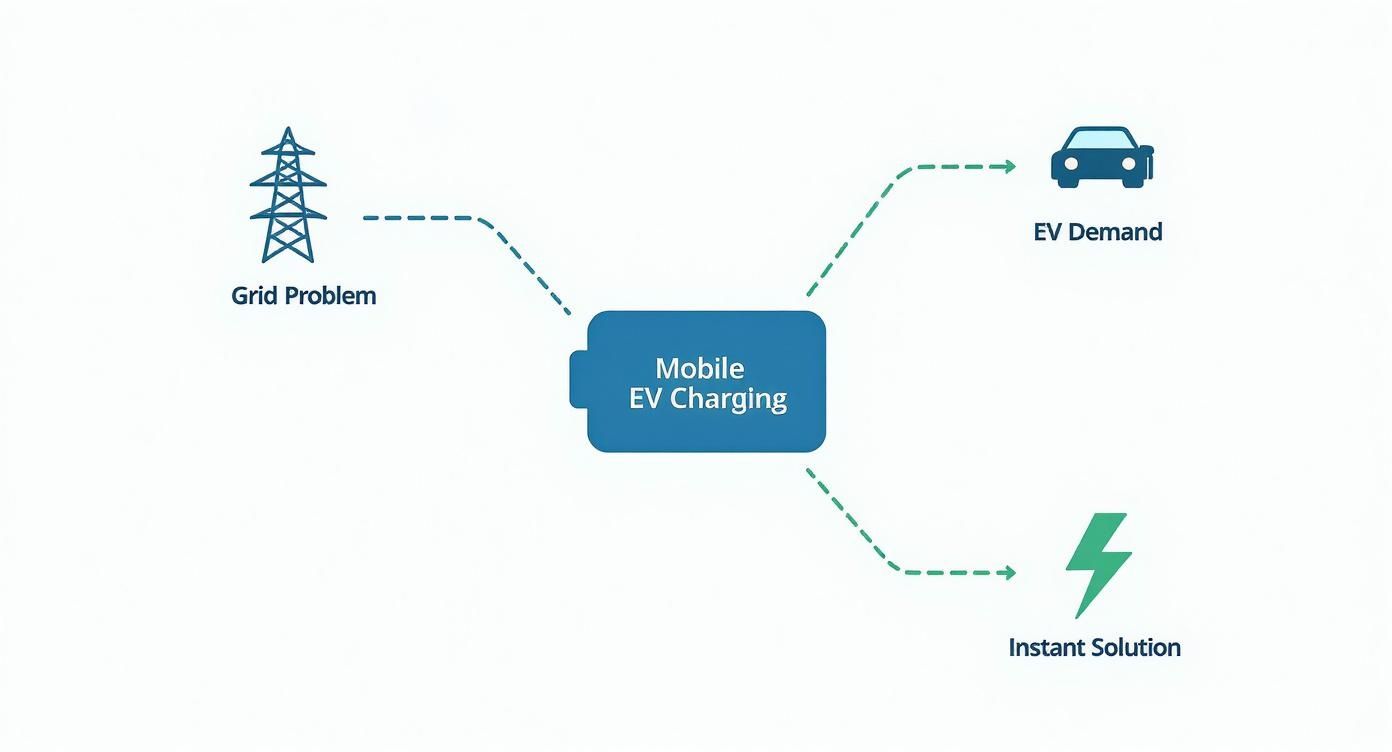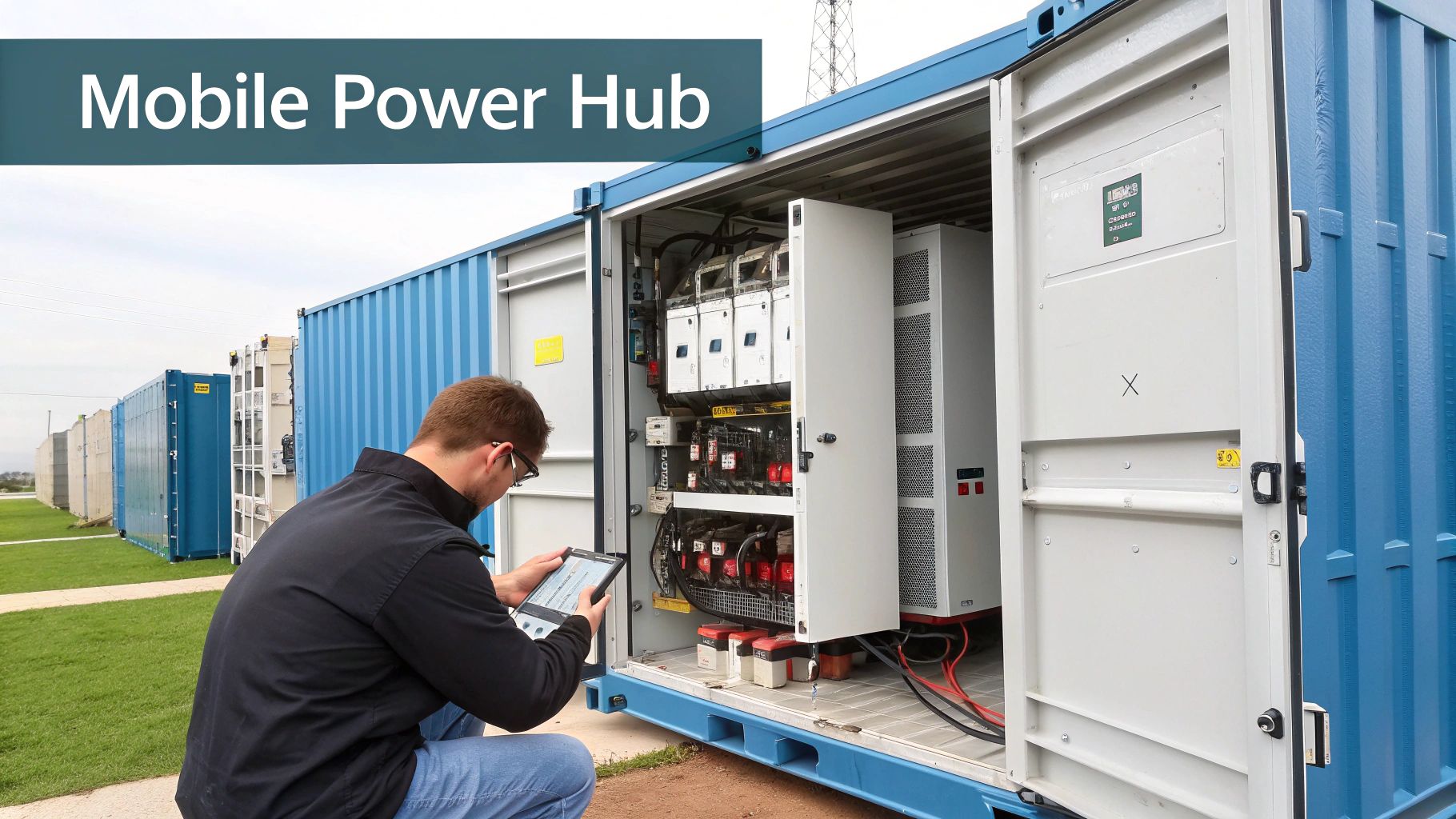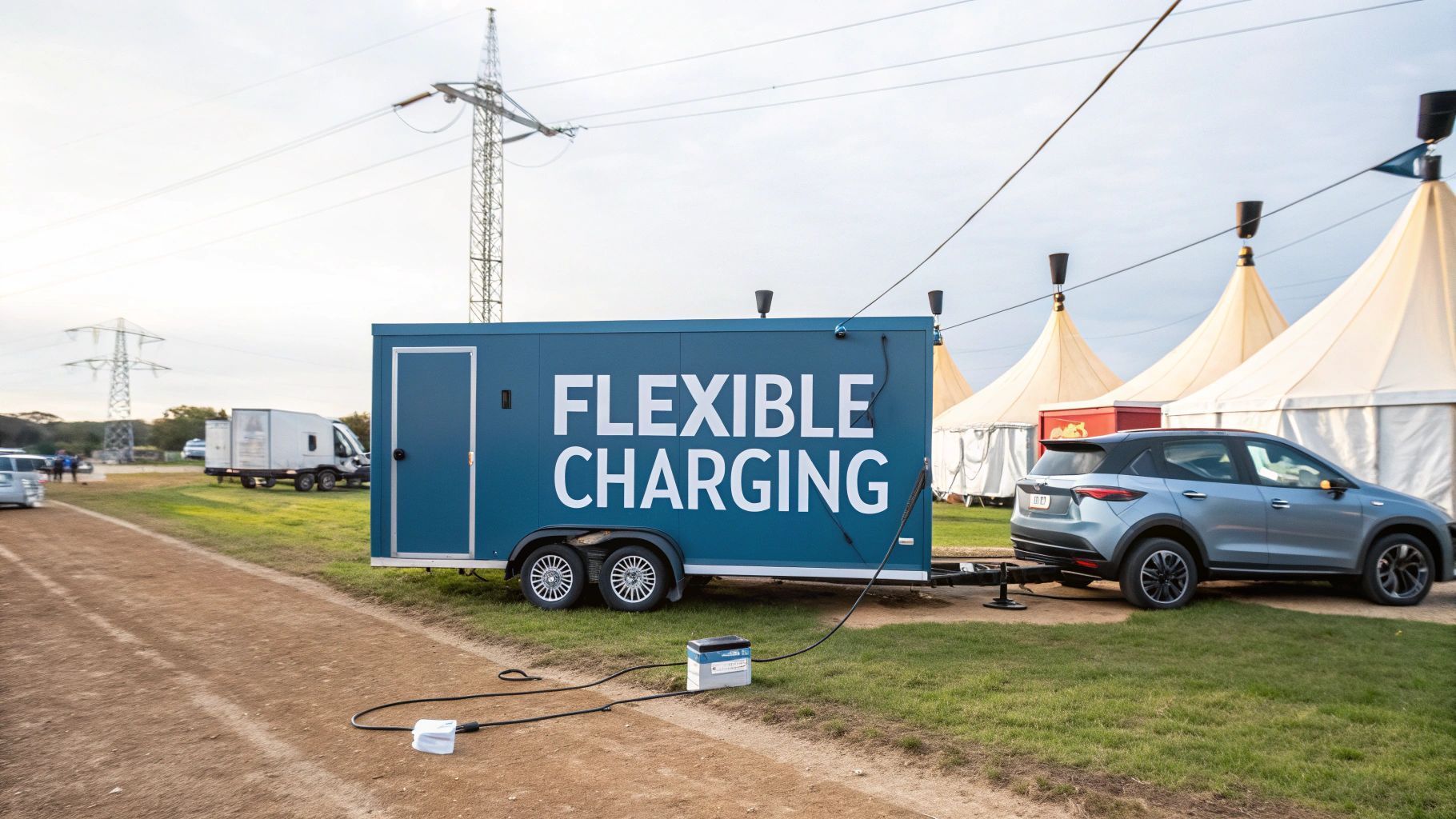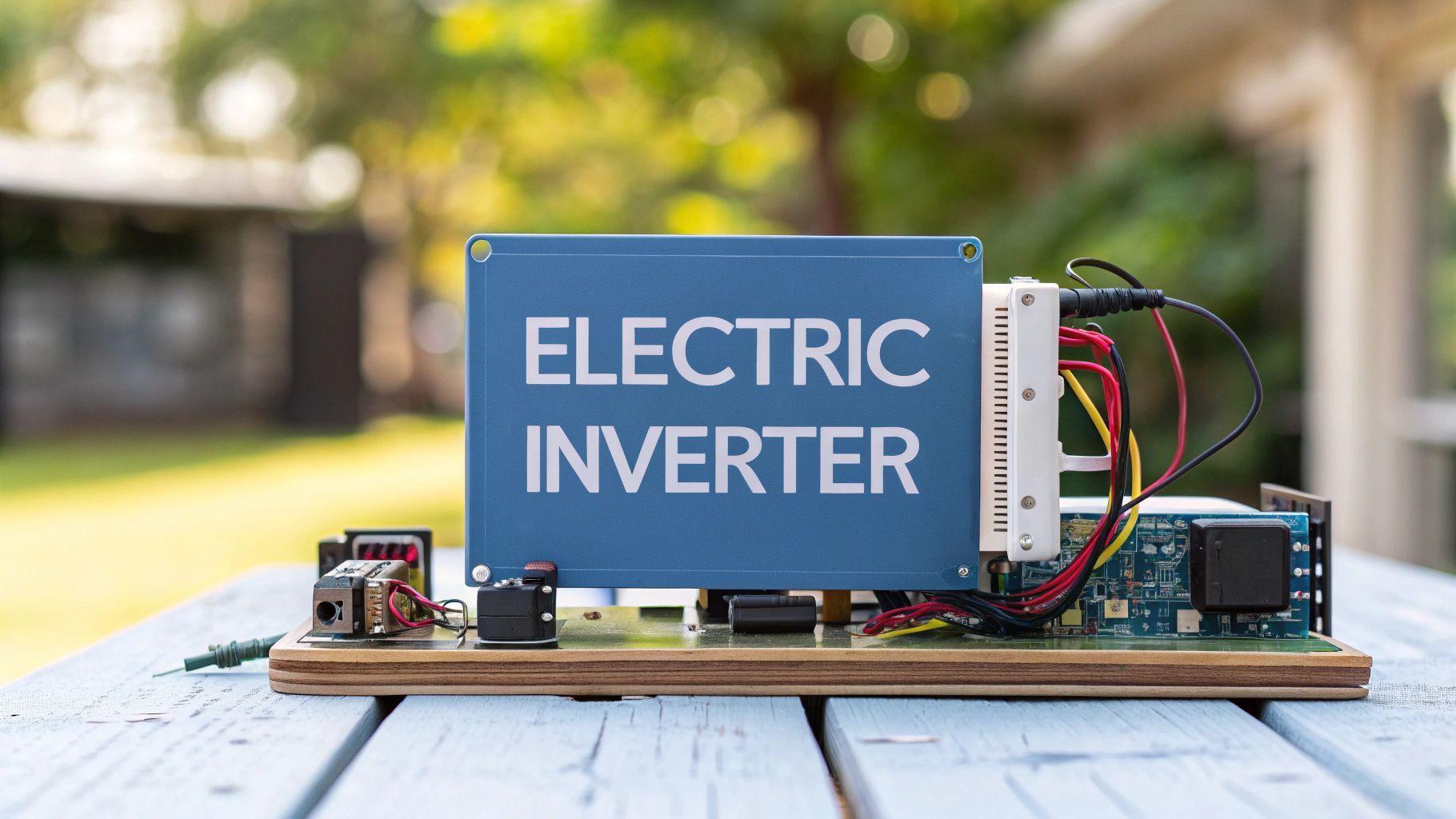Mobile EV Charging: Powering Britain's Future
Picture this: you need a high-speed electric vehicle charger but you can't wait months for a grid connection. What if you could have one delivered exactly where you need it, ready to go? That’s the real power of mobile EV charging . This isn't just about breakdown cover anymore; it's a strategic answer to one of the UK's biggest electrification headaches.
Why Mobile Charging Is Reshaping EV Infrastructure
As more people across the UK switch to electric vehicles, the demand for fast, accessible charging is starting to outstrip what the national grid can handle. Getting new, permanent high-power chargers installed is often a painfully slow and expensive affair, creating frustrating bottlenecks that slow everything down.
This is exactly where mobile EV charging steps in, not just as a handy backup but as a vital piece of our national infrastructure puzzle.
Think of these mobile units as giant, powerful 'power banks for cars'. They can be dropped off pretty much anywhere to provide rapid EV charging on demand, whether that's a muddy festival field, a busy construction site, or a commercial depot still waiting on its grid upgrade. That kind of flexibility is essential if we're going to support the growing number of EVs hitting British roads.
The Growing Need for Flexible Solutions
The UK's charging network is expanding fast. In just a year, public charging points jumped by over 34% . But with a ratio of one public charger for every 17 EVs, there are still big gaps, especially for businesses and at temporary sites where digging in permanent infrastructure just doesn't make sense.
This is the gap mobile EV charging was born to fill. It offers a nimble, immediate response to fluctuating demand and those inevitable infrastructure delays, making sure power is right where it needs to be, when it needs to be there.
Mobile EV charging decouples charging availability from fixed grid locations. It represents a fundamental shift from building infrastructure to deploying energy as a flexible, on-demand service.
To really get your head around how these mobile solutions fit into the grander scheme, it helps to understand the wider world of EV infrastructure. This comprehensive guide to electric vehicle charging infrastructure is a great starting point. Mobile units aren't just a replacement for fixed chargers; they're a crucial complement, helping the UK hit its ambitious electrification targets without getting bogged down by delays.
Solving Grid Connection Bottlenecks
One of the biggest roadblocks holding back the UK's rapid EV charging network isn't the chargers themselves—it's the local electricity grid. Many ideal locations simply don't have the capacity to handle permanent, high-power chargers. We call these constrained grid connections .
Getting the necessary upgrades done can be a painfully slow and expensive slog. We're talking months, sometimes even years, and costs that can easily run into a fortune. It’s a major headache for anyone trying to expand charging infrastructure.
This is exactly where mobile EV charging, especially systems with large-scale batteries built-in, offers such an elegant way forward. These units neatly sidestep the whole grid connection drama, giving you instant access to rapid charging power without needing a massive infrastructure overhaul.
Think of a mobile Battery Energy Storage System (BESS) as a bit like a power reservoir. It can be trickle-fed from a low-power, single-phase connection—perhaps overnight when electricity is cheaper and demand is low. Once it's full, it’s ready to unleash a powerful surge of energy during the day, capable of charging multiple EVs at top speed.
Decoupling Charging Speed from Grid Capacity
This simple but powerful idea breaks the direct link between how fast a car can charge and how strong the grid connection is. The mobile unit does all the heavy lifting, which means a site with a weak connection can still deliver the kind of rapid EV charging speeds that drivers and fleet operators need.
Suddenly, this opens up a huge range of possibilities for businesses and public services, making rapid EV charging a reality in places where it was previously a non-starter.
- Remote Locations: Picture service stations in rural spots or tourist destinations far from the nearest major power lines.
- Commercial Depots: Fleet operators can electrify their vans and lorries without the long wait for costly grid upgrades at their depots.
- Temporary Event Sites: Music festivals, sporting events, and exhibitions can now be properly equipped with high-power charging for visitors and their own vehicles.
This infographic really captures how mobile charging bridges the gap between today’s grid limitations and the growing demand for modern EV charging.

The image makes it clear how a mobile system acts as the immediate answer, connecting the problem of grid constraints with the need for fast charging. By acting as an intermediary energy store, it delivers the power right where and when it's needed most.
To put it into perspective, let’s compare the two approaches side-by-side.
Fixed Versus Mobile Rapid Charging Solutions
| Attribute | Fixed Rapid Charging | Mobile EV Charging (with BESS) |
|---|---|---|
| Grid Requirement | High-capacity, three-phase connection | Low-capacity, single-phase connection |
| Deployment Time | 6-24 months (pending grid upgrades) | Days to weeks |
| Installation Cost | High, often includes major civil works | Significantly lower, minimal groundworks |
| Location Flexibility | Permanent, fixed installation | Fully mobile, can be relocated as needed |
| Scalability | Difficult and expensive to add more units | Easy to scale by adding more mobile units |
| Key Challenge | Grid connection delays and high costs | Requires space for the unit and refilling |
As you can see, while permanent installations have their place, the mobile approach offers an agility and speed that is simply unmatched when dealing with grid constraints.
By storing energy from any available source and deploying it on demand, mobile EV charging transforms a grid limitation into a logistical advantage. It's not just about providing a charge; it's about delivering power intelligently.
This distributed energy model is absolutely vital for building a more resilient and flexible charging network across the country. You can dive deeper into how these battery-backed EV charging systems work to truly grasp their full potential. Ultimately, they offer a faster, more cost-effective route to getting the rapid charging infrastructure the UK urgently needs.
The Technology Behind Mobile Power
To deliver serious charging speeds just about anywhere, a mobile EV charging unit has to be a lot more than just a battery on wheels. These systems are actually sophisticated, self-contained energy hubs, properly engineered to manage, store, and deliver huge amounts of power safely and efficiently.
Forget the smaller van-mounted units you see at the roadside for emergency rescues. The real game-changers are the larger, containerised systems.

Think of these as grid-scale batteries made portable, with enough grunt to energise an entire commercial fleet or create a pop-up charging forecourt from scratch. They cleverly combine high-capacity battery packs with intelligent software and power conversion technology, all packaged up for rapid deployment.
This integrated approach means they can pull in power from multiple sources—a weak grid connection, on-site solar panels, even a wind turbine—and bank that energy for when it’s needed most. It's this ability to combine on-site renewables with stored energy that makes them a cornerstone of modern, distributed energy strategies.
The Heart of the System: EV Charging and Batteries
At the very core of these powerful mobile units are the batteries themselves. The choice of battery chemistry here is critical and the industry has largely settled on Lithium Iron Phosphate (LFP) . Unlike some other lithium-ion chemistries, LFP is famous for its stability, safety, and long operational life, making it the perfect fit for the demanding cycles of rapid charging.
But the batteries are only half the story. An advanced Energy Management Software (EMS) acts as the brain of the whole operation, making sure everything works together seamlessly.
- Optimised Charging: The EMS figures out the best times to draw power from the grid—often overnight when energy is cheapest—which can dramatically slash running costs.
- Load Balancing: It intelligently shares power between multiple vehicles, ensuring every EV charges as quickly as possible without overloading the system.
- Renewable Integration: The software manages the flow of energy from any connected renewables, like solar panels, making the most of every bit of clean, free energy.
This blend of robust hardware and smart software creates a genuinely self-sufficient power source. You can dive deeper into how these complete mobile energy storage solutions provide a high-tech alternative to digging up the ground for fixed infrastructure.
A Self-Sufficient Energy Hub
When you pair a mobile EV charging unit with on-site renewables like solar panels, it evolves from a simple power source into a fully functional microgrid. It can generate its own clean electricity, store it, and then deploy it to charge vehicles whenever they pull up.
This kind of setup is ideal for off-grid locations or for any business looking to seriously boost its sustainability credentials. Picture a construction site using solar-powered mobile chargers to power its electric diggers and vans. The result is a completely self-sufficient and emissions-free operation.
By integrating grid-scale batteries, renewables, and intelligent software, a mobile EV charging unit becomes more than just a charger. It is a flexible, distributed energy resource that strengthens grid resilience and accelerates the transition to clean transport.
This technological foundation is what allows mobile EV charging to solve complex energy puzzles, delivering powerful, fast charging in places where it was once thought impossible.
Mobile EV Charging in the Real World

This is where the theory hits the road. The true value of mobile EV charging really clicks when you see it solving real-world headaches that fixed infrastructure just can't touch. Its sheer adaptability makes it a game-changer for all sorts of commercial and public needs, from powering temporary events to making sure essential fleets never run out of juice.
Think about a big music festival out in a remote field. Getting enough power for thousands of visitors, staff, and their EVs would normally mean a massive, costly grid connection project. A mobile charging unit, on the other hand, can be dropped in for the weekend, dishing out rapid charges without a single shovel hitting the ground.
Supporting Commercial Fleets and Retail Demand
Commercial depots are another perfect example. We speak to businesses all the time who are ready to go electric with their fleet but are staring down the barrel of a 12 to 18-month wait for a grid upgrade. Mobile EV charging neatly bridges that gap, letting the fleet electrify right away while the permanent kit is being sorted. For businesses where vehicle uptime is everything, this sidesteps some seriously costly delays. Our own fleet EV charging practical guide for UK businesses digs much deeper into these kinds of strategies.
It’s a similar story for retail parks and shopping centres. They get absolutely swamped with traffic during seasonal peaks like Christmas. Instead of sinking a fortune into permanent chargers that sit empty for most of the year, they can deploy pop-up charging hubs to handle the rush. It’s a smart, flexible, and cost-effective way to keep EV drivers happy when it matters most.
Mobile charging is a versatile solution that shifts the focus from building fixed infrastructure to deploying energy as a flexible, on-demand service. It meets power needs precisely where and when they arise.
Powering Roadside Assistance and a Growing Network
Of course, the classic use case is roadside assistance. A mobile unit can get out to a stranded driver and deliver a rapid top-up in minutes. That gets them back on their way far quicker than waiting for a tow truck to haul them to the nearest static charger. As more people switch to EVs, this is only going to become more important.
The UK's public charging network is growing at a blistering pace to keep up. As this expansion continues, mobile charging plays a vital supporting role, filling in the gaps and bringing power to places the fixed network hasn't reached yet.
Weaving Mobile Charging into Your Business Plan
Thinking about mobile EV charging isn't just about providing a bit of power on the side; it's a strategic move. For any business wrestling with a maxed-out grid connection or stuck in a long queue for infrastructure upgrades, it’s a practical, right-now solution. The first step, always, is to get a real-world grip on your energy needs.
This is where an energy audit comes in. It’s essential. It’ll tell you exactly how much power your fleet is drawing, pinpoint when you’re using the most energy, and give you a solid baseline to plan from. This data is the foundation for figuring out the right size and capacity for any mobile charging unit you bring in.
Once you’ve got a clear picture of your energy profile, the numbers start to make sense. You can put the huge upfront cost and frustrating delays of a grid upgrade side-by-side with the more manageable operational cost of leasing a mobile battery system. For many, sidestepping a six-figure bill for a new grid connection makes mobile charging a no-brainer.
Gaining a Strategic Edge
Looking past the immediate cost savings, mobile charging offers some serious strategic advantages. It lets your business get in early, establishing a charging footprint in underserved areas long before competitors can even break ground on permanent infrastructure.
This flexibility also means your fleet uptime is maximised . Instead of having valuable vehicles sitting idle while you wait for a grid connection to be signed off, they can be out on the road, earning their keep from day one. And let's not forget, deploying a battery-powered charger that you can top up with renewables gives your company’s green credentials a massive boost—something that customers and stakeholders genuinely care about.
Mobile EV charging isn't just a temporary fix. It’s a strategic tool that turns an infrastructure headache into a competitive advantage, enabling faster electrification, greater operational flexibility, and a much stronger green brand.
Choosing the Right Mobile EV Charging Partner
Picking the right provider is absolutely critical. Not all mobile systems are built the same and asking the right questions from the get-go ensures you end up with a solution that actually fits your goals. A good partner will want to dig into your specific needs, not just push a one-size-fits-all box.
Before you sign anything, have a chat with potential providers and be sure to ask:
- What’s the total usable energy of the unit in kWh? This tells you how many vehicles you can actually charge before it needs a refill.
- What charging speeds can it deliver in kW? You need to know it can handle the rapid charging your fleet depends on.
- How do you recharge the unit itself and how long does it take? Get a clear understanding of the logistics involved in keeping it topped up.
- What kind of energy management software is included? Smart software is vital for optimising charging schedules and keeping running costs down.
- What are the full costs? Ask about everything—delivery, installation, and ongoing maintenance. You’re looking for complete transparency to avoid any nasty surprises down the line.
The Future of Distributed Energy and Charging
It’s easy to see mobile EV charging as just a convenient stopgap but that’s only scratching the surface. These systems are a critical piece of a much bigger puzzle: creating a smarter, more resilient energy future for everyone. By acting as distributed energy resources, these large battery systems are set to play a huge part in keeping the national grid stable.
Think of them enabling services like peak shaving , where they discharge power during the busiest times to ease the strain on the grid. Or demand response , where they soak up excess energy when renewables are generating more than we need.
This completely flips the script on the relationship between EV charging and the grid. Instead of just taking power out, a network of mobile chargers can work together as a ‘virtual power plant’. Imagine dozens of these units storing cheap wind energy overnight and then feeding it back into the system during the evening rush. It’s a game-changer.
Creating a Smarter, More Resilient Grid
This teamwork between mobile batteries, renewables, and smart grid management is absolutely vital for the UK’s energy transition. The public charging network is exploding—in just one year, the number of chargers grew by 37% . But this rapid growth brings its own headaches, like balancing the load in different regions and managing the heavy demand from rapid chargers, which now make up 20% of the network. You can dive deeper into the national EV charging landscape in EVC&I's latest report.
Mobile charging units transform a potential grid strain into a grid asset. They offer the flexibility to store, move, and deploy energy precisely where it is needed, strengthening the entire system.
On top of this, the technology fits perfectly with emerging Vehicle-to-Grid (V2G) ideas, where individual EVs can also send power back to the grid. Mobile batteries can act as the aggregator for all this distributed energy, creating a powerful, flexible resource that supports grid stability both locally and nationally.
It’s this kind of forward-thinking approach that ensures as more people switch to EVs, our charging infrastructure actually strengthens our energy system instead of straining it. This is how we secure a genuinely sustainable energy future for the UK.
Got Questions? We Have Answers
When you start digging into mobile EV charging, a few common questions always pop up. Here’s a straightforward look at how this flexible technology works and where it fits into the bigger picture.
How Fast Is Mobile EV Charging Compared to Fixed Chargers?
This is the best part – our mobile EV charging systems can deliver the exact same rapid speeds as their fixed counterparts, often providing power from 50kW to well over 150kW .
The secret is the large battery on board. The unit can be charged up slowly from even a weak grid connection, storing all that energy. Then, it can release it at high speed to the vehicle, meaning the car’s charging rate is never held back by the local power supply.
Is Mobile EV Charging Just for Emergencies?
While mobile charging is a lifesaver for roadside assistance, its real power lies in being a strategic, planned infrastructure solution. Think of it less as a spare tyre and more as a portable power station designed to solve complex energy headaches.
Businesses are already using mobile charging to:
- Power entire fleet depots where the grid connection is too weak.
- Bring temporary rapid EV charging to events or construction sites.
- Set up charging hubs where permanent grid upgrades would be far too slow or expensive.
What Is the Environmental Impact of Mobile EV Chargers?
Modern battery-based systems like ours have fantastic green credentials. They can be charged using renewable energy, either from integrated solar panels or by drawing from the grid during off-peak hours when wind and solar power are most abundant.
By storing clean energy and deploying it on demand, mobile EV charging units help reduce our reliance on fossil fuel generators. They actively support a more sustainable, distributed energy model.
This natural partnership between EV charging and battery storage allows businesses to use green energy even when the sun isn’t shining or the wind isn’t blowing. The ability to integrate with on-site renewables makes mobile charging a vital piece of a cleaner, more resilient energy future.
At ZPN Energy , we provide advanced mobile EV charging and battery storage solutions to solve your most complex energy challenges. Learn how our technology can accelerate your electrification goals.








